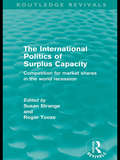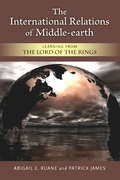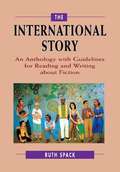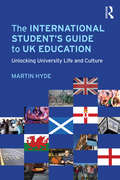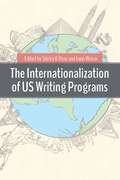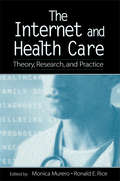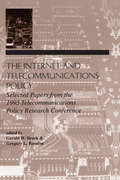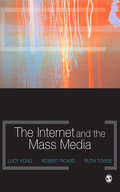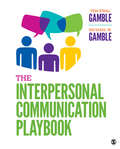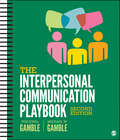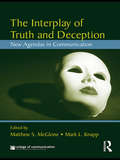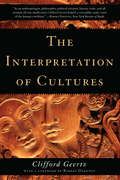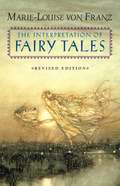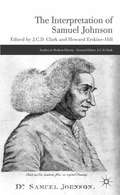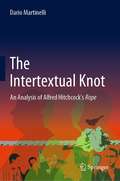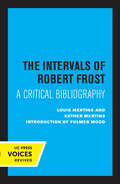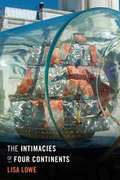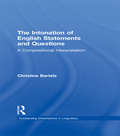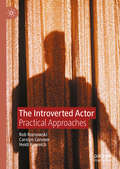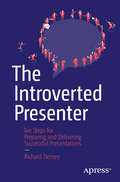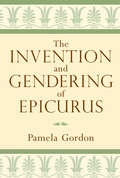- Table View
- List View
The International Politics of Surplus Capacity: Competition for Market Shares in the World Recession (Routledge Revivals)
by Susan Strange Roger ToozeThis important survey, first published in 1981, presents some different and often contending perceptions of the problem of surplus capacity as it re-emerged in the world of the 1980s – an economic climate with many parallels to the current era. Susan Strange and Roger Tooze deliberately assembled writers of many different nationalities, professional backgrounds and ideological convictions and asked them to make the case for their version of the problem. Some even doubt if there really is much of a problem at all. Others see it as fundamentally political, or monetary; as inherent in the capitalist system, or as the product of short-sighted pressure groups and perverse politicians. To help readers judge for themselves, there are specialist contributions on surplus capacity as it has shown up in different sectors of the world economy – shipbuilding, textiles, steel, petrochemicals, insurance and banking – and on the responses of different actors in the international system, including the European Community and multinational corporations.
The International Relations of Middle-earth: Learning from the Lord of the Rings
by Abigail E. Ruane Patrick JamesBased on their successful undergraduate course at the University of Southern California, Abigail E. Ruane and Patrick James provide an introduction to International Relations using J. R. R. Tolkien's fantastically popular trilogy The Lord of the Rings. Because Tolkien's major themes---such as good versus evil and human agency versus determinism---are perennially relevant to International Relations, The Lord of the Rings is well suited for application to the study of politics in our own world. This innovative combination of social science and humanities approaches to illustrate key concepts engages students and stimulates critical thinking in new and exciting ways.
The International Story: An Anthology with Guidelines for Reading and Writing about Fiction
by Ruth SpackThe International Story is an anthology with guidelines for reading and writing about fiction.
The International Student's Guide to UK Education: Unlocking University Life and Culture
by Martin HydeAre you thinking of studying at university in Britain? Do you feel confused about which course is best for you, which university to choose, and how to apply? Are you wondering about what kinds of challenges you will be faced with, how best to approach them and how to overcome them? If so, this guidebook is for you. Honest and accurate, this book acts as an international student introduction and cultural guide to UK Higher Education. It informs and guides students in their preparation for all aspects of UK HE, from university selection and application through to participation, and provides a clear understanding of how British universities function. Helping international students make the most of the many opportunities that university offers, this text will expand your knowledge of UK Higher Education with regards to: Application procedures Finances Self-awareness, cultural understanding and adaptation (social and academic) University administrative procedures, facilities and support Work and career information and advice. The International Student’s Guide to UK Education is a comprehensive guide that will help students to develop critical and reflective ability in order to become independent, well-informed and empowered decision makers.
The Internationalization of US Writing Programs
by Shirley K RoseThe Internationalization of US Writing Programs illuminates the role writing programs and WPAs play in defining goals, curriculum, placement, assessment, faculty development, and instruction for international student populations. The volume offers multiple theoretical approaches to the work of writing programs and illustrates a wide range of well-planned writing program–based empirical research projects. As of 2016, over 425,000 international students were enrolled as undergraduates in US colleges and universities, part of a decade-long trend of increasing numbers of international students coming to the United States for both undergraduate and graduate degrees. Writing program administrators and writing teachers across the country are beginning to recognize this changing demographic as a useful catalyst for change in writing programs, which are tasked with preparing all students, regardless of initial level of English proficiency, for academic and professional writing. The Internationalization of US Writing Programs is the first collection to focus specifically on this crucial aspect of the roles and responsibilities of WPAs, who are leading efforts to provide all students on their campuses, regardless of nationality or first language, with competencies in writing that will serve them in the academy and beyond. Contributors: Jonathan Benda, Michael Dedek, Christiane Donahue, Chris W. Gallagher, Kristi Girdharry, Tarez Samra Graban, Jennifer E. Haan, Paula Harrington, Yu-Kyung Kang, Neal Lerner, David S. Martins, Paul Kei Matsuda, Heidi A. McKee, Libby Miles, Susan Miller-Cochran, Matt Noonan, Katherine Daily O’Meara, Carolina Pelaez-Morales, Stacey Sheriff, Gail Shuck, Christine M. Tardy, Stanley Van Horn, Daniel Wilber, Margaret Willard-Traub
The Internet and Health Care: Theory, Research, and Practice (Routledge Communication Series)
by Ronald E. Rice Monica MureroThe Internet and Health Care: Theory, Research, and Practice presents an in-depth introduction to the field of health care and the Internet, from international and interdisciplinary perspectives. It combines expertise in the areas of the social sciences, medicine, policy, and systems analysis. With an international collection of contributors, it provides a current examination of key issues and research projects in the area. Methods and data used in the chapters include personal interviews, focus groups, observations, regional and national surveys, online transcript analysis, and much more. Sections in the book cover:*e-Health trends and theory; *searching, discussing, and evaluating online health information at the individual level of analysis; *discussing health information at the group or community level; and *implementing health information systems at the regional and social level. The Internet and Health Care will prove useful for university educators and students in the social, public health, and medical disciplines, including Internet researchers. It is also oriented to professionals in many disciplines who will appreciate an integrative theoretical, empirical, and critical analysis of the subject matter, including developers and providers of online health information.
The Internet and Telecommunications Policy: Selected Papers From the 1995 Telecommunications Policy Research Conference (Lea Telecommunications Ser.)
by Gerald W. Brock, Gregory L. RosstonThis book is based on the Telecommunications Policy Research Conference which reports on research into telecommunications policy issues. While the conference is now a respectable 23 years old, this is only the second printed edition of selected papers. A new law, the Telecommunications Act of 1996, accelerated the process of integration in the communication industry and made major revisions to the Communications Act of 1934 that increase the incentive for integration within the industry. Although the papers in this volume were written prior to the passage of the new law, their importance is merely enhanced by it. They deal with fundamental, complex policy problems that arise when previously separate segments of the telecommunications industry are integrated, rather than specific regulatory rules that are likely to be changed under the new law. With the passage of this law, the timeframe for developing appropriate policies for an integrated industry has been shortened. Changes expected to occur over a period of several years will now likely occur much more rapidly. These papers provide insights to help guide the transition in the industry. Divided into five parts, this volume: * deals with problems of transforming local exchange telephone service from a monopoly in each geographical area to an interconnected competitive network of networks, * considers the pricing problems that arise in an integrated network carrying traffic of different types across multiple service providers, * examines the problem of achieving interoperability in complex networks, * considers issues of intellectual property that arise in expected integrated networks of the future, and * discusses electronic publication of scholarly journals, copyright protection, and the applicability of copyright law in the digital age.
The Internet and the Mass Media
by Ruth Towse Robert G. Picard Lucy Keung"This book analyses issues of the internet and mass media in a rapidly changing environment. It covers a wide range of fundamentals which will be in effect for a longer time, and reflects the benefits of international and interdisciplinary collaboration." - Heinz-Werner Nienstedt, President, European Media Management Education Association "This excellent book will be of great use to researchers, teachers and students interested in the relationship between the Internet and the mass media and it offers an invaluable contribution to the literature. The overall picture that emerges from this book is one that is very balanced, stressing both the radical potential of the internet and the ways in which the various media sectors have experienced the impact differently." - Colin Sparks, University of Westminster What impact has the Internet really had on the media industries? What new regulatory policies and business models are driven by the Internet? And what are the effects of the Internet on how we produce, access and consume music, film, television and other media content? After an initial flurry of analysis and prediction of the future of the dot com boom, this is the first book to review the developments of the first Internet era and investigate its actual outcomes. Bringing together sophisticated analyses from leading scholars in the field, The Internet and the Mass Media explores the far-reaching implications of the Internet from economic, regulatory, strategic and organizational perspectives. This cross-disciplinary, international view is essential for a rich, nuanced understanding of the many technological, economic, and social changes the Internet has brought to the way we live and work.
The Interpersonal Communication Playbook
by Teri Kwal Gamble Michael W. GamblePractical skills for developing successful relationships—both face-to-face and online Written in a conversational style and presented in an innovative handbook format, The Interpersonal Communication Playbook empowers you to take an active role in the development of your communication skills. Best-selling authors Teri Kwal Gamble and Michael Gamble provide you with abundant opportunities to make personal observations, analyze personal experiences, and assess personal growth across interpersonal contexts. Offering an array of communication settings for you to practice your skills, this text makes it easy for you to see how relevant theory can be applied to develop and maintain healthy relationships with family, friends, romantic partners, and coworkers. Key Features Insightful, relatable examples and real-world scenarios engage you and encourage you to critically reflect on your own communication dynamics. “Learning objectives at the beginning of each chapter outline key objectives and help you master important concepts and prepare for exams. Opening vignettes introduce the relevance of chapter content through a contemporary example of communication in action, exemplifying chapter themes with engaging and relevant stories. “What Do You Know?” features promotes self-assessment of knowledge and encourages you to address any misconceptions you discover. “Try This” boxes promote active learning and provide you with opportunities to put your skills into practice. “Reflect On This” boxes connect theory with practice—bringing key concepts and ideas to life. “Analyze This” boxes encourage you to apply critical thinking to examples of interpersonal encounters from literature and popular culture. “Connect the Case” features includes chapter-ending cases designed to help you assess interpersonal communication outcomes to help solidify and further develop the skills learned.
The Interpersonal Communication Playbook
by Teri Kwal Gamble Michael W. GamblePractical skills for developing successful relationships—both face-to-face and online Written in a conversational style and presented in an innovative handbook format, The Interpersonal Communication Playbook empowers you to take an active role in the development of your communication skills. Best-selling authors Teri Kwal Gamble and Michael Gamble provide you with abundant opportunities to make personal observations, analyze personal experiences, and assess personal growth across interpersonal contexts. Offering an array of communication settings for you to practice your skills, this text makes it easy for you to see how relevant theory can be applied to develop and maintain healthy relationships with family, friends, romantic partners, and coworkers. Key Features Insightful, relatable examples and real-world scenarios engage you and encourage you to critically reflect on your own communication dynamics. “Learning objectives at the beginning of each chapter outline key objectives and help you master important concepts and prepare for exams. Opening vignettes introduce the relevance of chapter content through a contemporary example of communication in action, exemplifying chapter themes with engaging and relevant stories. “What Do You Know?” features promotes self-assessment of knowledge and encourages you to address any misconceptions you discover. “Try This” boxes promote active learning and provide you with opportunities to put your skills into practice. “Reflect On This” boxes connect theory with practice—bringing key concepts and ideas to life. “Analyze This” boxes encourage you to apply critical thinking to examples of interpersonal encounters from literature and popular culture. “Connect the Case” features includes chapter-ending cases designed to help you assess interpersonal communication outcomes to help solidify and further develop the skills learned.
The Interpersonal Communication Playbook
by Teri Kwal Gamble Michael W. GambleWritten in a conversational style and presented in an innovative handbook format, The Interpersonal Communication Playbook empowers students to take an active role in the development of their communication skills in both physical and digital arenas. Bestselling authors Teri Kwal Gamble and Michael W. Gamble provide students with ample opportunities to make personal observations, examine personal experiences, and assess their personal growth across interpersonal contexts. The Second Edition features a new chapter on The Cultural Dynamics of Interpersonal Communication in response to the COVID-19 pandemic and lessons learned on adapting communication skills to changing conditions, ways to develop communication resiliency, and the value in practicing mindfulness. This title is accompanied by a complete teaching and learning package. Contact your SAGE representative to request a demo. Learning Platform / Courseware SAGE Vantage is an intuitive learning platform that integrates quality SAGE textbook content with assignable multimedia activities and auto-graded assessments to drive student engagement and ensure accountability. Unparalleled in its ease of use and built for dynamic teaching and learning, Vantage offers customizable LMS integration and best-in-class support. It’s a learning platform you, and your students, will actually love. Learn more. Assignable Video with Assessment Assignable video (available in SAGE Vantage) is tied to learning objectives and curated exclusively for this text to bring concepts to life. Watch a sample video now. LMS Cartridge: Import this title’s instructor resources into your school’s learning management system (LMS) and save time. Don’t use an LMS? You can still access all of the same online resources for this title via the password-protected Instructor Resource Site. Learn more.
The Interpersonal Communication Playbook
by Teri Kwal Gamble Michael W. GambleWritten in a conversational style and presented in an innovative handbook format, The Interpersonal Communication Playbook empowers students to take an active role in the development of their communication skills in both physical and digital arenas. Bestselling authors Teri Kwal Gamble and Michael W. Gamble provide students with ample opportunities to make personal observations, examine personal experiences, and assess their personal growth across interpersonal contexts. The Second Edition features a new chapter on The Cultural Dynamics of Interpersonal Communication in response to the COVID-19 pandemic and lessons learned on adapting communication skills to changing conditions, ways to develop communication resiliency, and the value in practicing mindfulness. This title is accompanied by a complete teaching and learning package. Contact your SAGE representative to request a demo. Learning Platform / Courseware SAGE Vantage is an intuitive learning platform that integrates quality SAGE textbook content with assignable multimedia activities and auto-graded assessments to drive student engagement and ensure accountability. Unparalleled in its ease of use and built for dynamic teaching and learning, Vantage offers customizable LMS integration and best-in-class support. It’s a learning platform you, and your students, will actually love. Learn more. Assignable Video with Assessment Assignable video (available in SAGE Vantage) is tied to learning objectives and curated exclusively for this text to bring concepts to life. Watch a sample video now. LMS Cartridge: Import this title’s instructor resources into your school’s learning management system (LMS) and save time. Don’t use an LMS? You can still access all of the same online resources for this title via the password-protected Instructor Resource Site. Learn more.
The Interplay of Truth and Deception: New Agendas in Theory and Research (New Agendas in Communication Series)
by Mark L. Knapp Matthew S. McGloneDuring the past 30 years, there have been a steadily increasing number of scientific and popular publications dealing with lying and deception. Questions about the extent to which public officials are deceptive are standard fare in current magazines and newspapers. This volume aims to present on a more precise conceptualization of this phenomenon, manifested in some well-known constructions like spin, hype, doublespeak, equivocation, and contextomy (quoting out of context). The contents of the volume have been generated for the New Agendas symposium at the University of Texas College of Communication, and all the authors are young, leading-edge researchers offering innovative perspectives and explorations of lying and deception in various contexts. This volume will appeal to scholars, researchers, and advanced/graduate students in communication, media, and psychology. It is written to the level of advanced undergraduates, and it is appropriate for use in courses covering lying and deception.
The Interpretation of Cultures
by Clifford Geertz Robert DarntonIn The Interpretation of Cultures, the most original anthropologist of his generation moved far beyond the traditional confines of his discipline to develop an important new concept of culture. This groundbreaking book, winner of the 1974 Sorokin Award of the American Sociological Association, helped define for an entire generation of anthropologists what their field is ultimately about.
The Interpretation of Fairy Tales: Revised Edition
by Marie-Louise von FranzOf the various types of mythological literature, fairy tales are the simplest and purest expressions of the collective unconscious and thus offer the clearest understanding of the basic patterns of the human psyche. Every people or nation has its own way of experiencing this psychic reality, and so a study of the world's fairy tales yields a wealth of insights into the archetypal experiences of humankind.Perhaps the foremost authority on the psychological interpretation of fairy tales is Marie-Louise von Franz. In this book—originally published as An Introduction to the Interpretation of Fairy Tales —she describes the steps involved in analyzing and illustrates them with a variety of European tales, from "Beauty and the Beast" to "The Robber Bridegroom."Dr. von Franz begins with a history of the study of fairy tales and the various theories of interpretation. By way of illustration she presents a detailed examination of a simple Grimm's tale, "The Three Feathers," followed by a comprehensive discussion of motifs related to Jung's concept of the shadow, the anima, and the animus. This revised edition has been corrected and updated by the author.
The Interpretation of Samuel Johnson (Studies In Modern History Ser.)
by Jonathan Clark Howard Erskine-HillA major academic controversy has raged in recent years over the analysis of the political and religious commitments of Samuel Johnson, the most commanding of the 'commanding heights' of eighteenth-century English letters. This book, one of a trilogy from Palgrave, brings that debate to a decisive conclusion, retrieving the 'historic Johnson' as opposed to the 'usable Johnson' that had been devised in the early twentieth century. The trilogy makes untenable the old picture of a Johnson who was Olympian, detached from the conflicts of his age, a timeless moralist. It reinstates a man well-informed about and deeply committed to the conflicts of his era in Church and State, in theology and in political ideology. And instead of a timeless, unchanging Johnson, it offers a picture of a man whose views importantly developed over the course of his agonized lifetime.
The Interpreter's Companion
by Holly MikkelsonThe terminology in this edition covers six subject areas: legal, traffic & automotive, drugs, weapons, medical, and profanity & slang.
The Intertextual Knot: An Analysis of Alfred Hitchcock’s Rope
by Dario MartinelliThis book is a thorough analysis of Alfred Hitchcock's Rope (1948) and of its multiple connections with the Leopold and Loeb murder case and the adaptation of Patrick Hamilton’s eponymous play. As an all-encompassing portrait of the movie, the book discusses its aesthetics, style, role within cinema history, challenges in production, innovations introduced and of course Hitchcock’s signature features. However, as the analysis unfolds, the film reveals itself as an actual journey through the nightmares and the hopes that characterized the 20th century. Nazism and anti-Nazism, antisemitism, homophobia, democracy and totalitarianism, capital punishment and second chances, human rights, World War II, misogyny, tolerance and discrimination, Supermanism and humanism, artistic freedom and censorship. Subtly, often between the lines, and with Hitchcock's usual dark humor, Rope is nevertheless a much stronger social and political statement than it was ever given credit for. The Intertextual Knot is aimed at a varied readership, including film scholars, historians, philosophers and film enthusiasts.
The Intervals of Robert Frost: A Critical Bibliography
by Louis Mertins Esther MertinsThis title is part of UC Press's Voices Revived program, which commemorates University of California Press’s mission to seek out and cultivate the brightest minds and give them voice, reach, and impact. Drawing on a backlist dating to 1893, Voices Revived makes high-quality, peer-reviewed scholarship accessible once again using print-on-demand technology. This title was originally published in 1947.
The Interview: Research on Its Anatomy and Structure
by Arthur N. WiensNearly two decades of research in clinic, industry, and educational settings have enabled the authors to present this compact but comprehensive report on the structure of the interview process. Joseph D. Matarazzo and Arthur N. Wiens have put together a concise presentation of research evidence; free from the dogged adherence to personal opinion that plagues most literature on the subject. The authors present and discuss basic interview concepts: interviewer and interviewee difference in interview behavior, the stability of such behavior, and conditions, which may modify it (including the first solid evidence, independently cross validated by others, for the effect on the interviewee of specific and common interviewer tactics).The book contains a wealth of data on differences in the interview speech behavior of different types of patients, and between persons in different occupations, different administrative hierarchies, and different professional specialties (for example surgical versus psychiatric nurses). Data from the clinical setting also includes evidence for a new and heretofore unsuspected process variable; i.e., a synchrony in the interruption behavior of the therapist and his patient over many psychotherapy sessions.The undergraduate in the communications fields will find this book an excellent adjunct to any of a number of courses in his special curriculum. Graduate students will find a storehouse of leads for theses and dissertations; while the practitioner and teacher in these fields will find much that is new and important to him in each chapter.
The Intimacies of Four Continents
by Lisa LoweIn this uniquely interdisciplinary work, Lisa Lowe examines the relationships between Europe, Africa, Asia, and the Americas in the late eighteenth- and early nineteenth- centuries, exploring the links between colonialism, slavery, imperial trades and Western liberalism. Reading across archives, canons, and continents, Lowe connects the liberal narrative of freedom overcoming slavery to the expansion of Anglo-American empire, observing that abstract promises of freedom often obscure their embeddedness within colonial conditions. Race and social difference, Lowe contends, are enduring remainders of colonial processes through which "the human" is universalized and "freed" by liberal forms, while the peoples who create the conditions of possibility for that freedom are assimilated or forgotten. Analyzing the archive of liberalism alongside the colonial state archives from which it has been separated, Lowe offers new methods for interpreting the past, examining events well documented in archives, and those matters absent, whether actively suppressed or merely deemed insignificant. Lowe invents a mode of reading intimately, which defies accepted national boundaries and disrupts given chronologies, complicating our conceptions of history, politics, economics, and culture, and ultimately, knowledge itself.
The Intonation of English Statements and Questions: A Compositional Interpretation (Outstanding Dissertations in Linguistics)
by Christine BartelsEnglish sentence prosody provides cues to both focus structure and speaker attitude. Taking the phonological model of intonation developed by Pierrehumbert (1880 et seq.) as point of departure, this work illuminates the communicative function of English pitch contours by (1) giving a detailed survey of phrase-final contours found in statements and questions, and (2) investigating what attitudinal features determine choice of phrasal tones in these utterance types. This comprehensive study will be of interest to linguists in a number of fields, ranging from prosody to semantics, pragmatics, and discourse analysis.
The Introverted Actor: Practical Approaches
by Rob Roznowski Carolyn Conover Heidi KasevichDo you have to be an extrovert to succeed as an actor? This book offers ideas to create inclusive acting environments where the strengths of the introverted actor are as valued as those of their extroverted counterparts. As this book shows, many introverts are innately drawn to the field of acting, but can often feel inferior to their extroverted peers. From the classroom to professional auditions, from rehearsals to networking events, introverted actors tell their stories to help other actors better understand how to leverage their natural gifts, both onstage and off. In addition, The Introverted Actor helps to reimagine professional and pedagogical approaches for both actor educators and directors by offering actionable advice from seasoned psychology experts, professional actors, and award-winning educators.
The Introverted Presenter
by Richard TierneyThe introvert is a personality type that draws energy from the outside inward. According to standard personality testing assessments, most people are introverts and no group is more introverted than technical professionals. Introverts are congenitally programmed to recoil from the prospect of public speaking with fear and loathing, yet making presentations to expert and non-expert audiences is an inescapable requirement for career advancement in any technical field. Presentation coach Richard Tierney rides to the rescue of fellow introverts in the IT and engineering sectors with The Introverted Presenter--his fail-safe guide to delivering competent presentations, no matter how unsuited by nature you might be to the performing arts. This short book lays out the complete process guaranteed to raise you from a debilitating state of terror and aversion to a comfortable place of clarity, calm, and competence--perhaps even brilliance, if you can train yourself to convert the free energy of your fear into controlled performance. Tierney repeatedly warns his introvert readers that they risk presentation fiasco if they skip, skimp, or change the order of any of the ten steps he prescribes for thoroughly and efficiently preparing their presentations. The surefire sequence of steps for The Introverted Presenter begins with defining your presentation''s audience and objective. The next step is to write the script of your speech in stages, constructing it on the basis of proven structural rules, cognitive laws, and dramatic tricks. Then you incrementally refine and tighten your script by delivering it iteratively, first in front of a mirror and then in front of increasingly critical test audiences, progressing from your cat to your boss. When you have a well-constructed and sound-tested script in hand and only then, you may create some slides to graft into your script in support of your opening action call and your concluding takeaways, which you commit to memory. Your slides should be limited to the smallest number possible (even zero) and the fewest possible words. What you''ll learn By following the process precisely as described in this book, even the most introverted technology professional will gradually but surely acquire the ability to Structure a killer presentation Coach yourself into being the best performer you can be Craft a presentation that supplies your audience''s technical needs while activating its human sympathies Use slides sparingly for best supporting effect Deploy elements of stagecraft like a trouper Who this book is for The primary readership is technology professionals who ordinarily shun the public-speaking limelight but find they need to pitch their work outside their team environments. The secondary readership is non-extroverts in the corporate, commercial, or academic worlds who have taken career promotions that involve presentations as part of their job descriptions. Table of Contents Chapter 1. Introverts and Presentations: Harnessing Terror Chapter 2. Face the Presentation Specter: Feared More Than Death Chapter 3. Find Your Presentation''s Focus: Ready, Steady Chapter 4. Impose Your Presentation''s Structure: Taking the Reins Chapter 5. Write Your Speech: Fear Returns Chapter 6. Refine Your Speech: Relishing the Panic Chapter 7. Try On Your Presenting Persona: Trotting the Course Chapter 8. Master Your Presentation Technology: Bending the Servant to Your Will Chapter 9. Chunk Your Presentation: Linking Primacy, Latency, and Failsafe Devices Chapter 10. Rehearse Your Presentation: Practice, Practice till Thoroughly Bored Chapter 11. Deliver Your Presentation: Treading the Hustings Like a Trouper Chapter 12. Encore! Rolling On to Your Next Presentation Chapter 13. Instant Clarity: Scaring Up an Emergency Presentation in One Day
The Invention and Gendering of Epicurus
by Pamela GordonThe school of Greek philosopher Epicurus, which became known as the Garden, famously put great stock in happiness and pleasure. As a philosophical community, and a way of seeing the world, Epicureanism had a centuries-long life in Athens and Rome, as well as across the Mediterranean. The Invention and Gendering of Epicurusstudies how the Garden's outlook on pleasure captured Greek and Roman imaginations---particularly among non-Epicureans---for generations after its legendary founding. Unsympathetic sources from disparate eras generally focus not on historic personages but on the symbolic Epicurean. And yet the traditions of this imagined Garden, with its disreputable women and unmanly men, give us intermittent glimpses of historical Epicureans and their conceptions of the Epicurean life. Pamela Gordon suggests how a close hearing and contextualization of anti-Epicurean discourse leads us to a better understanding of the cultural history of Epicureanism. Her primary focus is on sources hostile to the Garden, but her Epicurean-friendly perspective is apparent throughout. Her engagement with ancient anti-Epicurean texts makes more palpable their impact on modern responses to the Garden. Intended both for students and for scholars of Epicureanism and its response, the volume is organized primarily according to the themes common among Epicurus' detractors. It considers the place of women in Epicurean circles, as well as the role of Epicurean philosophy in Homer and other writers.
